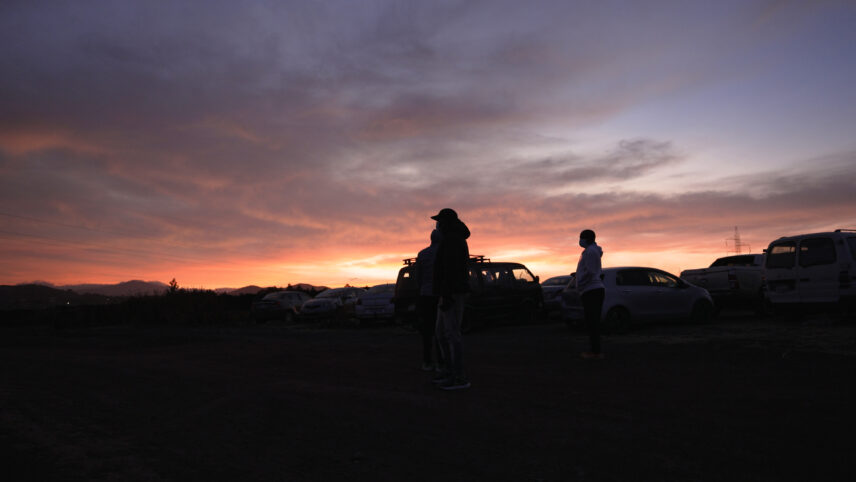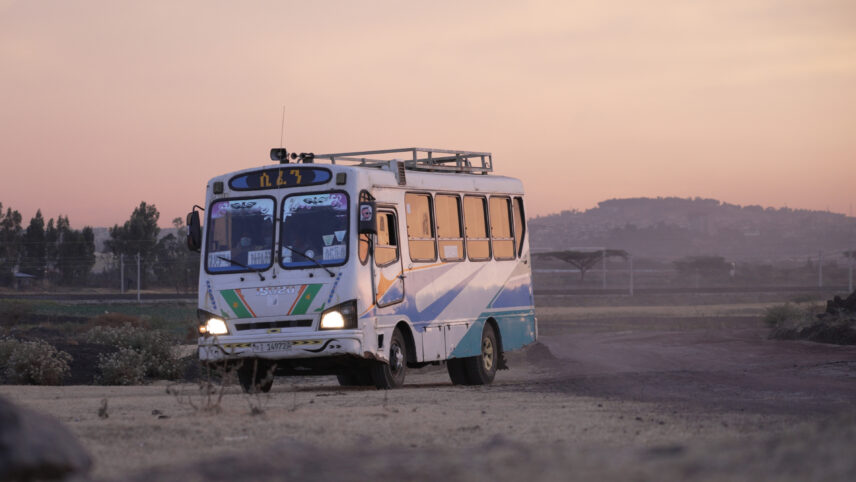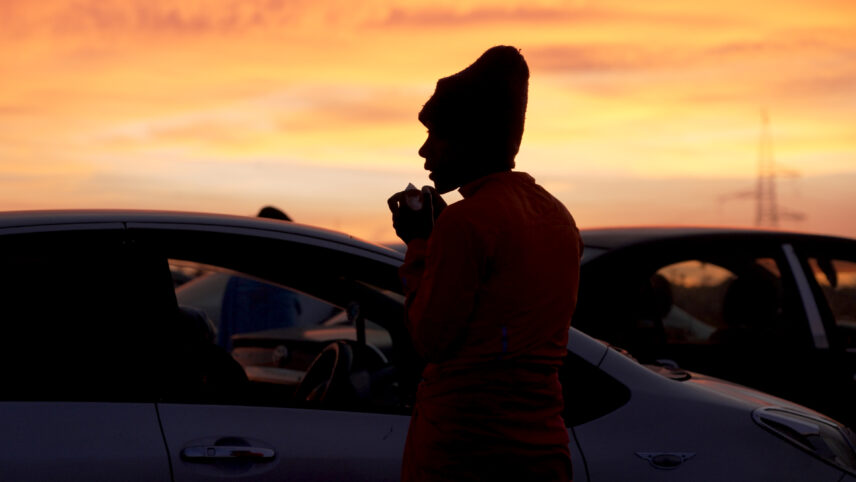Article begins
4:23 a.m.
My alarm goes off. I rise. Slowly. Technically, I am still asleep. I think… I quickly brush my teeth and throw on the layers I selected the night before―long running tights, T-shirt, long-sleeve shirt, and puffy jacket. Waking up well before daybreak is a part of the daily training schedule for Ethiopian athletes. Hundreds of runners―both aspiring and accomplished―in the Addis Ababa area are accustomed to getting out of bed and into their stride in this liminal urban time.
Most runners are up and about early, regardless of what stage they are at in their career. But the group I am researching is an elite-level management group with a few different tiers of athletes. Some are world-class runners. Others have begun to change their lives by winning small races in Asia. Another set of runners have been selected by coaches to join their group but have not yet signed a contract or necessarily raced abroad.
There is some sense of solidarity at beginning the day in this darkness. Some are getting ready amid a slew of awards in fancy new homes on the outskirts of Addis Ababa, their children sleeping in rooms adorned with European toys bought after winning marathons abroad. Others are confined to small, shoebox-sized rooms in shared compounds without running water.
It’s chilly before sunrise in Addis Ababa and the surrounding environs. Temperatures dip below the 50s Fahrenheit (10 Celsius) before they gradually warm with the day. When I arrive at today’s training destination, Akaki, I’ll switch the puffy out for a windbreaker to match the other runners who will, quite literally, leave me in the dust. Akaki is an area south of Addis characterized by red dirt roads; by the time we haul our bodies over the finish line our clothes, and usually calves, will be caked with amber muck.
But right now, as I glimpse out our window, I see the darkness is still and quiet. Once I am awake on days like these, the cold, quiet nighttime feels like a special invitation. I feel like the athletes own the city, and they have invited only a select cadre of characters into their story.
4:30 a.m.
The light is on in the room I share with my then partner; we quickly say good morning but have only allowed ourselves about 10 minutes to get ready, so we speak little. We check our bags to make sure we have water, dry clothes to change into after training, necessary gels and powders, and then head out the door.
Outside, it is pitch black.
When we leave the compound, we quickly run into others in the training group. Walking briskly, tiny runners in puffy coats, we take up the width of an empty street as we make our way to a waiting minibus at the Kotobe terminal.

Kotobe is a neighborhood on the northeastern side of Addis Ababa where many runners live. It is a relatively easy commute to the center of the city and the neighborhood skirts the edge of a forest that stretches back to the Entoto Mountains. The forest used to be much bigger and greener, before development projects began to erode its verdant borders. But athletes, especially those without cars, enjoy access to the forest for afternoon runs and light training days, when they’ll zigzag through the eucalyptus trees.
My relative discomfort in the darkness is yet another marker of the fact that running has never been a full-time job for me in the way that it is for my companions. Streetlights fail to illuminate the mix of pot-holed asphalt roads and cobblestone streets we walk down to get to the bus stop. My companions never seem to miss a step whereas I feel compelled to pull out my flashlight at each poorly lit spot, telling myself, “Don’t break your ankle to blend in.”
We greet each other with pleasantries, “Selam new, indet a derk,” etc. (“Hi, how are you? Good morning”). But we don’t talk much. I don’t know the level of nerves before today’s long run, but our silence might have more to do with the quietude of the night.
I’ve questioned many athletes on the need to get up so early, masking my own desire to sleep by raising questions about adequate recovery: “Don’t athletes need as much sleep as possible?” “Wouldn’t the training sessions be more productive if we were all maximally rested?” “Shouldn’t athletes prepare to run in a range of conditions, rather than the cool brisk mornings around Addis?” Sports scientists are keen to remind us that sleep is the most important recovery tool, but my questions are met with skepticism and never initiate a change in training times.
Athletes have told me over the years that it is important to wake up this early and traverse the city to beat the traffic; indeed, a 30-minute outbound trip may take over two hours on the return journey, getting some home around noon. Michael Crawley notes in Out of Thin Air that Ethiopian runners feel compelled to “work with the environment”; travelling to, and running in, varied training environments is vital in improving one’s condition―a trained embodiment that enables an athlete to work harder and race faster.
Athletes are also keen to emphasize the importance of training before the sun becomes too strong and the air too heavy. In 2014, one athlete told me that when she moved to Addis Ababa to train, she was told “Running after [11:00 a.m.] is not productive.” I pressed her on this, asking why, and she replied, “After [11:00 a.m.] the air is heavier. Which is to say the air is denser. The air is more dense in the morning and so if you run when the weather is more dense you’ll be less competent.” Attention to air, breathing, and training, irrespective of sleep patterns, is key to excelling in Ethiopian, and transitively, international running.

The alarms saved in my phone are at strange times: 4:27, 4:36, 4:41, 4:47. Each corresponds with a different training location, which in turn corresponds with a different focus. The places where athletes run relate to the type of training for that day. If we are going to meet in the Entoto forest, the emphasis will be on endurance and hills. If the destination is Sebeta, we’ll be going to develop our flat footspeed. Some require longer travel times than others, but we’ll always arise in the dark.
5:15 a.m.
We are supposed to be in Meganana―a central hub in Addis Ababa―by 5:00 a.m., but we arrive at 5:15. Sometimes this happens and there is little we can do. Luckily, the bus has not yet left, but when we pile on, I see that the only open seat is in the back. I push into the window as Selam slides in next to me. It will be an exceptionally bumpy ride once we get off the asphalt and onto the rougher Akaki roads.
The city streets are dark and almost empty. A few homeless people sleep on street corners. Meganana is quiet and still. By 7:00 a.m., it will begin to bustle and stay busily chaotic until about 10:00 p.m., a time during which it is impossible to take a few steps without bumping into other pedestrians. I try to remind myself, on days when it is particularly hard to get out of bed so early, that I will get to see Meganana in this rare light.
We’re at least illuminated as we get on the bus, lit by neon lights that remind us of Addis Ababa’s constant changes. We already passed by Marathon Motors―an offshoot of Ethiopian running legend Haile Gebreselassie’s car importing venture. We glimpse the dealership again at a roundabout by the towering Bellevue Hotel, owned and financed by Maryam Yusuf Jamal (formerly Zenebech Tola), an Olympic gold medalist from Ethiopia who later ran for Bahrain. So much of what we see are reminders of what can come of early morning training for those who “make it.”
Selam had not yet “made it” in the world of running when we met. She was not yet a professional in the strict sense. From the Amhara region, she was scouted by a member of the management team at a club competition the previous year. She moved to Addis Ababa to train with the top-level group, showing potential there. But like many athletes coming from clubs, she had not yet adjusted to the grueling marathon training session. She often finished early, foregoing the last few repetitions, as she adjusted to the sheer number of kilometers she was now running. That said, she would still brave the dark streets of Addis Ababa to make the 5:00 a.m. bus in whatever shoes she had.
But Selam often reminded me, as all athletes do at various stages in their careers, that this is her work. “I’m an athlete,” she would say, in contrast to civil (civilian), a term runners use among themselves to clarify that someone is not an athlete like them. At 5:00 a.m., most civil workers are sleeping. They will be on their way to work when we finish our first training session of the day, at around 8:00 or 9:00 a.m.
There is something else, I think, that makes training before light so significant in the working lives of Ethiopian athletes. It’s not merely that the air is less dense; or that the outbound journey is swift. Being awake this early marks one as fundamentally different to other city dwellers. Being out in the darkness, running in first light, is a part of what makes one an athlete.
There are a few people out and about in this early morning that is still the night: bus drivers, panhandlers, and others trying to hustle to make a living by moving around―inqasiqase. In his work on economies of the street in Addis Ababa, Marco Di Nunzio explores the relationship that young men have with their city as they live in a condition of marginality. Even though his interlocutors know that the odds are stacked against them, and that getting closer to a “good life” is statistically unlikely, they must continue to move, to uphold what Arjun Appadurai has called the “capacity to aspire.” Runners are similar. They must get up before others and maintain this aspiration toward greatness in order to succeed.
Runners are similar. They must get up before others and maintain this aspiration toward greatness in order to succeed.

6:15 a.m.
We arrive at the training destination, but people are slow to move. Outside, cars gradually roll up, the gravel crackling beneath their tires. For the athletes, owning a car was a primary indicator that one had achieved a certain level of success―to afford a vehicle but also other tools that could advance their training and recovery, like massage guns, compression socks, and regular appointments with massage therapists. Cars were evidence that these early morning labors could truly be transformative.
Runners and coaches slowly emerge from their respective vehicles to stretch. Wearing big coats or wrapped in gabi (a thick Ethiopian blanket), they stretch arms into the sky to loosen up their bodies and greet each other quietly. If athletes are nervous, they don’t seem to show it; against most norms and conventions, we all seem fairly happy to be there.
6:30 a.m.
The darkness is really fading now. The run has not started, but the work began hours ago. Small cohorts of runners link up and shuffle back and forth, beginning a long and gradual warm-up. At first, we barely lift our feet off the ground, and the sounds of crushed gravel muffle conversation. The warm-up pace gradually picks up and the sound of feet on the dirt road crescendos.
Next, a series of running drills often referred to as gymnastic. Runners form into a series of straight lines and move in perfect synchrony. We coordinate our small and gentle arm circles as our feet jog and lightly touch the ground. After a few variations we remain in our straight lines going back and forth along the dirt road, and we do a series of more familiar exercises. First high knees, then high knees with a turn, then high knees with a turn and a kick. As the exercise adds a component, the stomp down when we switch to the other leg becomes louder; still, in perfect synchrony, we switch from tapping the ground lightly with our toes to forcefully exploding off the ground.
In roughly two hours and 28 kilometers from now the run will be complete, but the labor unfinished. Returning to the city, then to our individual neighborhoods, we hopefully will make it back to Meganana by 11:00 a.m., where the city will have transformed.
But we’re still in our windbreakers as the warm-up winds down and the sun begins to fully emerge. We must change, quickly, and get started before the powerful UV rays threaten to slow the workout.
Runners scamper back onto the bus, into their cars, and behind bushes to shed layers, use the bathroom, and get ready for the training session. Some lather Vaseline on their bodies. Most switch their shoes. They arrive at the starting position newly chilled, holding their hands together above their chests, rubbing and slapping their legs, asking them to wake up in the darkness. It’s getting light now, and we’re ready to really begin.
But two days from now, well after dark, everyone will meet again.

